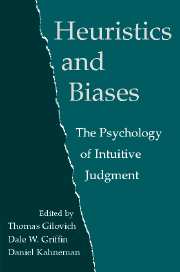Book contents
- Frontmatter
- Contents
- List of Contributors
- Preface
- Introduction – Heuristics and Biases: Then and Now
- PART ONE THEORETICAL AND EMPIRICAL EXTENSIONS
- PART TWO NEW THEORETICAL DIRECTIONS
- 22 Two Systems of Reasoning
- 23 The Affect Heuristic
- 24 Individual Differences in Reasoning: Implications for the Rationality Debate?
- 25 Support Theory: A Nonextensional Representation of Subjective Probability
- 26 Unpacking, Repacking, and Anchoring: Advances in Support Theory
- 27 Remarks on Support Theory: Recent Advances and Future Directions
- 28 The Use of Statistical Heuristics in Everyday Inductive Reasoning
- 29 Feelings as Information: Moods Influence Judgments and Processing Strategies
- 30 Automated Choice Heuristics
- 31 How Good Are Fast and Frugal Heuristics?
- 32 Intuitive Politicians, Theologians, and Prosecutors: Exploring the Empirical Implications of Deviant Functionalist Metaphors
- PART THREE REAL-WORLD APPLICATIONS
- References
- Index
23 - The Affect Heuristic
from PART TWO - NEW THEORETICAL DIRECTIONS
Published online by Cambridge University Press: 05 June 2012
- Frontmatter
- Contents
- List of Contributors
- Preface
- Introduction – Heuristics and Biases: Then and Now
- PART ONE THEORETICAL AND EMPIRICAL EXTENSIONS
- PART TWO NEW THEORETICAL DIRECTIONS
- 22 Two Systems of Reasoning
- 23 The Affect Heuristic
- 24 Individual Differences in Reasoning: Implications for the Rationality Debate?
- 25 Support Theory: A Nonextensional Representation of Subjective Probability
- 26 Unpacking, Repacking, and Anchoring: Advances in Support Theory
- 27 Remarks on Support Theory: Recent Advances and Future Directions
- 28 The Use of Statistical Heuristics in Everyday Inductive Reasoning
- 29 Feelings as Information: Moods Influence Judgments and Processing Strategies
- 30 Automated Choice Heuristics
- 31 How Good Are Fast and Frugal Heuristics?
- 32 Intuitive Politicians, Theologians, and Prosecutors: Exploring the Empirical Implications of Deviant Functionalist Metaphors
- PART THREE REAL-WORLD APPLICATIONS
- References
- Index
Summary
This chapter introduces a theoretical framework that describes the importance of affect in guiding judgments and decisions. As used here, affect means the specific quality of “goodness” or “badness” (1) experienced as a feeling state (with or without consciousness) and (2) demarcating a positive or negative quality of a stimulus. Affective responses occur rapidly and automatically – note how quickly you sense the feelings associated with the stimulus words treasure or hate. We argue that reliance on such feelings can be characterized as the affect heuristic. In this chapter, we trace the development of the affect heuristic across a variety of research paths followed by ourselves and many others. We also discuss some of the important practical implications resulting from ways that this heuristic impacts our daily lives.
BACKGROUND
Although affect has long played a key role in many behavioral theories, it has rarely been recognized as an important component of human judgment and decision making. Perhaps befitting its rationalistic origins, the main focus of descriptive decision research has been cognitive, rather than affective. When principles of utility maximization appeared to be descriptively inadequate, Simon (1956) oriented the field toward problem-solving and information-processing models based on bounded rationality. The work of Tversky and Kahneman (1974) and Kahneman, Slovic, and Tversky (1982) demonstrated how boundedly rational individuals use such heuristics as availability, representativeness, and anchoring and adjustment to make judgments, and how they use simplified strategies such as “elimination by aspects” to make choices (Tversky, 1972).
- Type
- Chapter
- Information
- Heuristics and BiasesThe Psychology of Intuitive Judgment, pp. 397 - 420Publisher: Cambridge University PressPrint publication year: 2002
- 750
- Cited by



